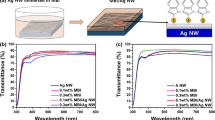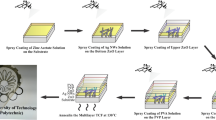Abstract
Silver nanowire (AgNW) network has been employed into many electronic devices as transparent electrode. However, the poor electrical stability under current shock has been seriously holding its practical application, and we still lack a long-term electrically stable AgNW system to study the underlying fundamentals of electrical failure. In this work, the electrical stability performance and failure mechanism of chitosan–ascorbic acid (Chi-AsA)/AgNW composite under current stress were thoroughly studied. The composite electrode maintained stable above 24,000 h under high current density of 100 mA cm−1. The main failure in AgNW composite is found to be a wave break perpendicular to the current instead of traditional uniform degradation across the entire AgNW networks. More interestingly, the AgNWs in failed composite electrode maintained their original smooth morphology excepting the crack region, while the AgNWs in pristine networks degraded to nanoparticles or became disconnected everywhere. The patterned AgNW composite in microscale exhibits long lifetime in resisting current stress as well. The effect of over-coating location, electrical stress, temperature, and over-coating materials on the electrical stability were studied. The over-coating layer of Chi-AsA is proven to suppress the silver atoms from electromigration, reduce the concentrated Joule heating at junctions, and inhibit the corrosion. The Chi-AsA/AgNW composite enables electrically stable transparent conductor for long-serving optoelectronics, and the mechanism investigation deepens the comprehension of preparing electrically stable AgNW system.







Similar content being viewed by others
References
S. Ye, A.R. Rathmell, Z. Chen, I.E. Stewart, B.J. Wiley, Metal nanowire networks: the next generation of transparent conductors. Adv. Mater. 26, 6670–6687 (2014)
N. Ye, J. Yan, S. Xie, Y. Kong, T. Liang, H. Chen, M. Xu, Silver nanowire-graphene hybrid transparent conductive electrodes for highly efficient inverted organic solar cells. Nanotechnology 28, 305402 (2017)
T.H. Seo, S. Lee, K.H. Min, S. Chandramohan, A.H. Park, G.H. Lee, M. Park, E.K. Suh, M.J. Kim, The role of graphene formed on silver nanowire transparent conductive electrode in ultra-violet light emitting diodes. Sci. Rep. 6, 29464 (2016)
R. Gupta, K.D. Rao, S. Kiruthika, G.U. Kulkarni, Visibly transparent heaters. ACS Appl. Mater. Interfaces 8, 12559–12575 (2016)
J. Lee, P. Lee, H. Lee, D. Lee, S.S. Lee, S.H. Ko, Very long Ag nanowire synthesis and its application in a highly transparent, conductive and flexible metal electrode touch panel. Nanoscale 4, 6408–6414 (2012)
S. Yao, Y. Zhu, Wearable multifunctional sensors using printed stretchable conductors made of silver nanowires. Nanoscale 6, 2345–2352 (2014)
D. Li, X. Liu, X. Chen, W.Y. Lai, W. Huang, A simple strategy towards highly conductive silver-nanowire inks for screen-printed flexible transparent conductive films and wearable energy-storage devices. Adv. Mater. Technol. 4, 1900196 (2019)
X. Liang, T. Zhao, W. Jiang, X. Yu, Y. Hu, P. Zhu, H. Zheng, R. Sun, C.-P. Wong, Highly transparent triboelectric nanogenerator utilizing in-situ chemically welded silver nanowire network as electrode for mechanical energy harvesting and body motion monitoring. Nano Energy 59, 508–516 (2019)
H.H. Khaligh, I.A. Goldthorpe, Failure of silver nanowire transparent electrodes under current flow. Nanoscale Res. Lett. 8, 235 (2013)
D. Chen, F. Zhao, K. Tong, G. Saldanha, C. Liu, Q. Pei, Mitigation of electrical failure of silver nanowires under current flow and the application for long lifetime organic light-emitting diodes. Adv. Electron. Mater. 2, 1600167 (2016)
X. Zhang, X. Yan, J. Chen, J. Zhao, Large-size graphene microsheets as a protective layer for transparent conductive silver nanowire film heaters. Carbon 69, 437–643 (2014)
N. Kwon, K. Kim, J. Heo, I. Yi, I. Chung, Study on Ag mesh/conductive oxide hybrid transparent electrode for film heaters. Nanotechnology 25, 265702 (2014)
S. Ji, W. He, K. Wang, Y. Ran, C. Ye, Thermal response of transparent silver nanowire/PEDOT:PSS film heaters. Small 10, 4951–4960 (2014)
Y. Jin, Y. Sun, K. Wang, Y. Chen, Z. Liang, Y. Xu, F. Xiao, Long-term stable silver nanowire transparent composite as bottom electrode for perovskite solar cells. Nano Res. 11, 1998–2011 (2018)
Y. Ahn, Y. Jeong, Y. Lee, Improved thermal oxidation stability of solution-processable silver nanowire transparent electrode by reduced graphene oxide. ACS Appl. Mater. Interfaces 4, 6410–6414 (2012)
D. Lee, H. Lee, Y. Ahn, Y. Jeong, D.Y. Lee, Y. Lee, Highly stable and flexible silver nanowire-graphene hybrid transparent conducting electrodes for emerging optoelectronic devices. Nanoscale 5, 7750–7755 (2013)
B.T. Camic, F. Oytun, M.H. Aslan, H.J. Shin, H. Choi, F. Basarir, Fabrication of a transparent conducting electrode based on graphene/silver nanowires via layer-by-layer method for organic photovoltaic devices. J Colloid Interface Sci. 505, 79–86 (2017)
X. Zhang, J. Wu, H. Liu, J. Wang, X. Zhao, Z. Xie, Efficient flexible polymer solar cells based on solution-processed reduced graphene oxide-assisted silver nanowire transparent electrode. Org Electron. 50, 255–263 (2017)
J. Liang, L. Li, K. Tong, Z. Ren, W. Hu, X. Niu, Y. Chen, Q. Pei, Silver nanowire percolation network soldered with graphene oxide at room temperature and its application for fully stretchable polymer light-emitting diodes. Small 8, 1590–1600 (2014)
H. Dong, Z. Wu, Y. Jiang, W. Liu, X. Li, B. Jiao, W. Abbas, X. Hou, A flexible and thin graphene/silver nanowires/polymer hybrid transparent electrode for optoelectronic devices. ACS Appl. Mater. Interfaces 8, 31212–31221 (2016)
T. Sannicolo, N. Charvin, L. Flandin, S. Kraus, D.T. Papanastasiou, C. Celle, J.P. Simonato, D. Muñoz-Rojas, C. Jiménez, D. Bellet, Electrical mapping of silver nanowire networks: a versatile tool for imaging network homogeneity and degradation dynamics during failure. ACS Nano 12, 4648–4659 (2018)
D. Fantanas, A. Brunton, S.J. Henley, R.A. Dorey, Investigation of the mechanism for current induced network failure for spray deposited silver nanowires. Nanotechnology 29, 465705 (2018)
A. Kumar, N.S. Vidhyadhiraja, G.U. Kulkarni, Current distribution in conducting nanowire networks. J. Appl. Phys. 122, 045101 (2017)
G. Deignanab, I.A. Goldthorpe, The dependence of silver nanowire stability on network composition and processing parameters. RSC Adv. 7, 35590–35597 (2017)
J.L. Elechiguerra, L. Larios-Lopez, C. Liu, D. Garcia-Gutierrez, A. Camacho-Bragado, M.J. Yacaman, Corrosion at the nanoscale: the case of silver nanowires and nanoparticles. Chem. Mater. 17, 6042–6052 (2005)
B.T. Liu, S.X. Huang, Transparent conductive silver nanowire electrodes with high resistance to oxidation and thermal shock. RSC Adv. 4, 59226–59232 (2014)
I.K. Moon, J.I. Kim, H. Lee, K. Hur, W.C. Kim, H. Lee, 2D graphene oxide nanosheets as an adhesive over-coating layer for flexible transparent conductive electrodes. Sci. Rep. 3, 1112 (2013)
H. Chen, M. Li, X. Wen, Y. Yang, D. He, W.C.H. Choy, H. Lu, Enhanced silver nanowire composite window electrode protected by large size graphene oxide sheets for perovskite solar cells. Nanomaterials 9, 193 (2019)
H.H. Khaligh, L. Xu, A. Khosropour, A. Madeira, M. Romano, C. Pradére, M. Tréguer-Delapierre, L. Servant, M.A. Pope, I.A. Goldthorpe, The Joule heating problem in silver nanowire transparent electrodes. Nanotechnology 28, 425703 (2017)
A.S. Alshammari, Improved electrical stability of silver NWs based hybrid transparent electrode interconnected with polymer functionalized CNTs. Mater. Res. Bull. 111, 245–250 (2019)
J.C. Goak, T.Y. Kim, D.U. Kim, K.S. Chang, C.S. Lee, N. Lee, Stable heating performance of carbon nanotube/silver nanowire transparent heaters. Appl. Surf. Sci. 510, 145445 (2020)
Y. Cai, X. Piao, X. Yao, W. Gao, E. Nie, Z. Zhang, Z. Sun, Transparent conductive film based on silver nanowires and single-wall carbon nanotubes for transparent heating films. Nanotechnology 30, 225201 (2019)
S. Chen, L. Song, Z. Tao, X. Shao, Y. Huang, Q. Cui, X. Guo, Neutral-pH PEDOT:PSS as over-coating layer for stable silver nanowire flexible transparent conductive films. Org Electron 15, 3654–3659 (2014)
J.S. Woo, J.T. Han, S. Jung, J.I. Jang, H.Y. Kim, H.J. Jeong, S.Y. Jeong, K.J. Baeg, G.W. Lee, Electrically robust metal nanowire network formation by in-situ interconnection with single-walled carbon nanotubes. Sci. Rep. 4, 4804 (2014)
S.J. Lee, J.-W. Kim, J.H. Park, Y. Porte, J.-H. Kim, J.-W. Park, S. Kim, J.-M. Myoung, SWCNT–Ag nanowire composite for transparent stretchable film heater with enhanced electrical stability. J. Mater. Sci. 53, 12284–12294 (2018)
Y. Zhu, T. Wan, P. Guan, Y. Wang, T. Wu, Z. Han, G. Tang, D. Chu, Improving thermal and electrical stability of silver nanowire network electrodes through integrating graphene oxide intermediate layers. J. Colloid Interface Sci. 566, 375–382 (2020)
V.H. Nguyen, J. Resende, D.T. Papanastasiou, N. Fontanals, C. Jiménez, D. Muñoz-Rojas, D. Bellet, Low-cost fabrication of flexible transparent electrodes based on Al doped ZnO and silver nanowire nanocomposites: impact of the network density. Nanoscale 11, 12097–12107 (2019)
H. Yu, N. Jin, Z. Wang, J. Lin, J. Wei, Q. Luo, C.Q. Ma, Use of solution-processed zinc oxide to prevent the breakdown in silver nanowire networks. Nanotechnology 31, 18LT01 (2020)
A. Khan, V.H. Nguyen, D. Muñoz-Rojas, S. Aghazadehchors, C. Jiménez, N.D. Nguyen, D. Bellet, Stability enhancement of silver nanowire networks with conformal ZnO coatings deposited by atmospheric pressure spatial atomic layer deposition. ACS Appl. Mater. Interfaces 10, 19208–19217 (2018)
M. Lagrange, T. Sannicolo, D. Muñoz-Rojas, B.G. Lohan, A. Khan, M. Anikin, C. Jiménez, F. Bruckert, Y. Bréchet, D. Bellet, Understanding the mechanisms leading to failure in metallic nanowire-based transparent heaters, and solution for stability enhancement. Nanotechnology 28, 055709 (2017)
C. Mayousse, C. Celle, A. Fraczkiewicz, J.P. Simonato, Stability of silver nanowire based electrodes under environmental and electrical stresses. Nanoscale 7, 2107–2115 (2015)
H. Lu, D. Zhang, J. Cheng, J. Liu, J. Mao, W.C.H. Choy, Locally welded silver nano-network transparent electrodes with high operational stability by a simple alcohol-based chemical approach. Adv. Funct. Mater. 25, 4211–4218 (2015)
S.J. Choi, S.J. Kim, J.S. Jang, J.H. Lee, I.D. Kim, Silver nanowire embedded colorless polyimide heater for wearable chemical sensors: improved reversible reaction kinetics of optically reduced graphene oxide. Small 12, 5826–5835 (2016)
K. Wang, Y. Jin, X. Wang, B. Qian, J. Wang, F. Xiao, Investigation into the failure mechanism of silver nanowire network film under electrical stress, in 2020 IEEE 70th electronic components and technology conference (ECTC). (IEEE, Orlando, 2020)
K.W. Cheuk, K. Pei, P.K.L. Chan, Degradation mechanism of a junction-free transparent silver network electrode. RSC Adv. 6, 73769–73775 (2016)
Acknowledgements
This study was sponsored by National Natural Science Foundation of China under Grant 51603043.
Author information
Authors and Affiliations
Corresponding authors
Ethics declarations
Conflict of interest
There are no conflict to declare.
Additional information
Publisher's Note
Springer Nature remains neutral with regard to jurisdictional claims in published maps and institutional affiliations.
Supplementary Information
Below is the link to the electronic supplementary material.
Rights and permissions
About this article
Cite this article
Wang, K., Jin, Y. & Xiao, F. Long-term electrically stable silver nanowire composite transparent electrode under high current density. J Mater Sci: Mater Electron 32, 20919–20935 (2021). https://doi.org/10.1007/s10854-021-06386-4
Received:
Accepted:
Published:
Issue Date:
DOI: https://doi.org/10.1007/s10854-021-06386-4




